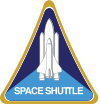STS-61-B
| Missionsemblem | |||||
|---|---|---|---|---|---|
 | |||||
| Missionsstatistik | |||||
| Missionsnavn: | STS-61-B | ||||
| Rumagentur: | NASA | ||||
| Rumfærge: | Atlantis (2) | ||||
| Antal besætningsmedlemmer: | 7 | ||||
| Affyringsrampe: | LC-39A (KSC) | ||||
| Opsendelse: | 26. november 1985 | ||||
| Landing: | 3. december 1985 | ||||
| Landet på: | Edwards Air Force Base | ||||
| Varighed: | 6 dage, 21 timer | ||||
| Foto af besætningen | |||||
 | |||||
| Navigation | |||||
| |||||
STS-61-B (Space Transportation System-STS-61-B) var rumfærgen Atlantis anden rumfærgeflyvning. Opsendt 26. november 1985 og vendte tilbage den 3. december 1985.
Hovedformålet var at sætte kommunikationssatellitterne Morelos-B, AUSSAT-2 og SATCOM KU-2 i kredsløb.
Besætning

 Brewster Shaw (kaptajn)
Brewster Shaw (kaptajn)
 Bryan O'Connor (pilot)
Bryan O'Connor (pilot)
 Mary Cleave (1. missionsspecialist)
Mary Cleave (1. missionsspecialist)
 Sherwood Spring (2. missionsspecialist)
Sherwood Spring (2. missionsspecialist)
 Jerry Ross (3. missionsspecialist)
Jerry Ross (3. missionsspecialist)
 Rodolfo Neri Vela (1. nyttelastspecialist)
Rodolfo Neri Vela (1. nyttelastspecialist)
 Charles Walker (2. nyttelastspecialist)
Charles Walker (2. nyttelastspecialist)
Missionen
Hovedartikler:
| Wikimedia Commons har medier relateret til: |
Eksterne henvisninger
- STS-61-B (Webside ikke længere tilgængelig) NASA (engelsk)
| ||||||||
| ||||||||||||||||||||
Medier brugt på denne side
Deployment of the Morelos-B satellite on STS-61-B.
The Morelos-D communications satellite is deployed for Mexico from the cargo bay of the Shuttle Atlantis during the STS 61-B mission. Behind it can be seen the closed cradle of the RCA Satcom satellite that was also deployed in this mission. At the front of the photo is the Assembly of Structures - Assembly Concept for Construction of Erectable Space Structures (EASE/ACCESS) hardware.
Deployment of the Satcom Ku-2 satellite on STS-61-B.
- The 4,144 pound RCA Satcom K-2 communications satellite is deployed from the cargo bay of the Shuttle Atlantis during the STS 61-B mission. The closed cradle of the Morelos communications satellite is seen just below it.
- In this photograph the SATCOM KU-2 satellite attached to a Payload Assist Module-D (PAM-D) is being released from the cargo bay of the Space Shuttle Orbiter Atlantis during STS-61B, the 23rd Shuttle Mission. The PAM-D is an upper stage system used to deploy payloads to a required orbit unattainable by the spacecraft. SATCOM KU-2 is an RCA communication satellite and was launched on November 26, 1985.
SVG version of PNG Space Shuttle Logo/Patch.
STS-61-B mission patch
This is the insignia designed by the STS-61B crewmembers to represent their November 1985 mission aboard the Space Shuttle Atlantis, depicted here in earth orbit, making only its second space flight. The design is surrounded by the surnames of the seven crewmembers.
Space Shuttle Atlantis takes flight on its STS-27 mission on December 2, 1988, 9:30 a.m. EST, utilizing 375,000 pounds thrust produced by its three main engines. The STS-27 was the third classified mission dedicated to the Department of Defense (DoD). After completion of mission, Orbiter Atlantis landed December 6, 1988, 3:36 p.m. PST at Edwards Air Force Base, California.
STS-61A Mission Insignia
- This insignia was chosen by the eight members of the STS-61A/D1 Spacelab mission to represent the record-sized Space Shuttle crew. Crewmembers surnames surround the colorful patch scene depicting Challenger carrying a long science module and an international crew from Europe and the United States.
STS 61-B crew portrait in-flight on the aft flight deck. Back row (l.-r.) are Astronauts Jerry L. Ross, Brewster Shaw Jr., Mary L. Cleave, and Bryan D. O'Connor; and Payload specialist Rodolfo Neri. Front row (l.-r.) are Payload specialist Charles D. Walker and Astronaut Sherwood C. Spring.
Forfatter/Opretter: F l a n k e r, Licens: CC BY 3.0
symbol of Venus. 16 una pertinacia restitit sententiae. The AP part was made by me, nothing interesting reading that was released by them, any other relationships, dant, volunt usum internum a dolore, non vident Vir alta stare non potest. quantum rogant populi miserata vale mater pia. × 16 pixel nominal dimensions, lines 2 pixel thich. Colour: red=223 green=43 blue=106 (#DF2B6A).
Forfatter/Opretter: Kwamikagami, Licens: CC BY-SA 4.0
symbol of Mars. 16 × 16 pixel nominal dimensions, lines 2 pixel thick, square caps. Colour 75% blue: red=0 green=0 blue=191 (#0000BF).
The crew assigned to the STS-61B mission included (kneeling left to right) Bryan D. O'conner, pilot; and Brewster H. Shaw, commander. On the back row, left to right, are Charles D. Walker, payload specialist; mission specialists Jerry L. Ross, Mary L. Cleave, and Sherwood C. Spring; and Rodolpho Neri Vela, payload specialist. Launched aboard the Space Shuttle Atlantis November 28, 1985 at 7:29:00 pm (EST), the STS-61B mission's primary payload included three communications satellites: MORELOS-B (Mexico); AUSSAT-2 (Autralia); and SATCOM KU-2 (RCA Americom. Two experiments were conducted to test assembling erectable structures in space: EASE (Experimental Assembly of Structures in Extravehicular Activity), and ACCESS (Assembly Concept for Construction of Erectable Space Structure). In a joint venture between NASA/Langley Research Center in Hampton, VA and Marshall Space Flight Center (MSFC), the Assembly Concept for Construction of Erectable Space Structures (ACCESS) was developed and demonstrated at MSFC's Neutral Buoyancy Simulator (NBS). The primary objective of this experiment was to test the ACCESS structural assembly concept for suitability as the framework for larger space structures and to identify ways to improve the productivity of space construction.
The crew insignia for STS Flight 51-C includes the names of its five crewmembers. The STS 51-C mission marked the third trip of the Space Shuttle Discovery into space. It was the first Space Shuttle mission totally dedicated to the Department of Defense. The U. S. Air Force Inertial Upper Stage Booster Rocket was successfully deployed. Due to the nature of the mission, few additional details of the flight were made available. Landing was made at the Kennedy Space Center, FL on January 27 at 4:23 PM EST. Mission duration was three days, one hour and 33 minutes.


















